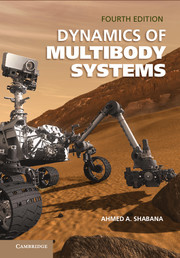Book contents
- Frontmatter
- Dedication
- Contents
- PREFACE
- 1 INTRODUCTION
- 2 REFERENCE KINEMATICS
- 3 ANALYTICAL TECHNIQUES
- 4 MECHANICS OF DEFORMABLE BODIES
- 5 FLOATING FRAME OF REFERENCE FORMULATION
- 6 FINITE-ELEMENT FORMULATION
- 7 THE LARGE DEFORMATION PROBLEM
- 8 CONCEPTS AND ESSENTIAL DETAILS
- APPENDIX: LINEAR ALGEBRA
- References
- Index
7 - THE LARGE DEFORMATION PROBLEM
Published online by Cambridge University Press: 05 June 2014
- Frontmatter
- Dedication
- Contents
- PREFACE
- 1 INTRODUCTION
- 2 REFERENCE KINEMATICS
- 3 ANALYTICAL TECHNIQUES
- 4 MECHANICS OF DEFORMABLE BODIES
- 5 FLOATING FRAME OF REFERENCE FORMULATION
- 6 FINITE-ELEMENT FORMULATION
- 7 THE LARGE DEFORMATION PROBLEM
- 8 CONCEPTS AND ESSENTIAL DETAILS
- APPENDIX: LINEAR ALGEBRA
- References
- Index
Summary
There are two main concerns regarding the use of the classical finite-element formulations in the large deformation and rotation analysis of flexible multibody systems. First, in the classical finite-element literature on beams and plates, infinitesimal rotations are used as nodal coordinates. Such a use of coordinates does not lead to the exact modeling of a simple rigid body motion. Second, lumped mass techniques are used in many finite-element formulations and computer programs to describe the inertia of the deformable bodies. As will be demonstrated in this chapter, such a lumped mass representation of the inertia also does not lead to exact modeling of the equations of motion of the rigid bodies.
In the preceding chapter, a floating frame of reference formulation that uses classical finite-element methodologies is developed. This formulation, in which infinitesimal rotations can be considered as nodal coordinates, can be used only in the large reference displacement and small elastic deformation with respect to the flexible body reference. Using the concept of the intermediate element coordinate system, which is equivalent to the application of the parallel axis theorem used in rigid body dynamics, a nonlinear formulation that leads to exact modeling of the rigid body motion for elements whose coordinates are defined in terms of infinitesimal rotations can be developed.
- Type
- Chapter
- Information
- Dynamics of Multibody Systems , pp. 304 - 338Publisher: Cambridge University PressPrint publication year: 2013
- 2
- Cited by

